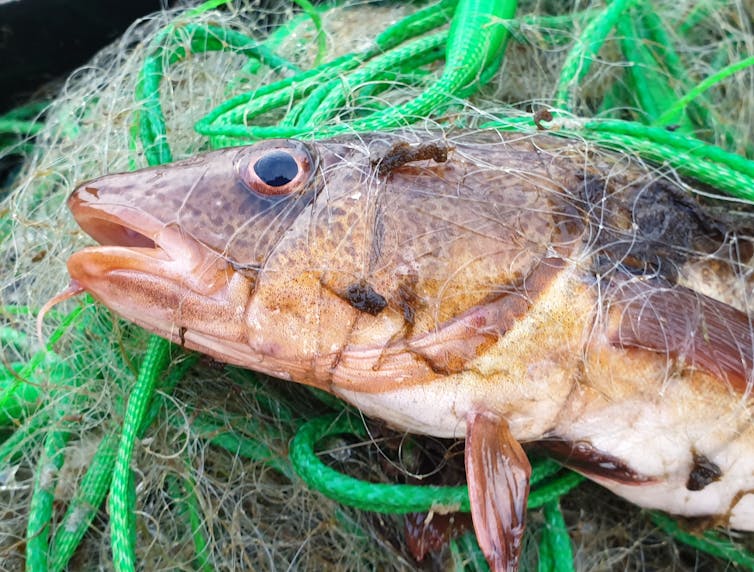Norway.- Farmed salmon often lose their sight in summer as cataracts make their eyes opaque. This happens when the temperature rises, but exactly why it happens has not been known. Scientists at NIFES have now found out more about the link between sea temperature and blindness in salmon.
Cataracts are an eye disorder that can affect both humans and fish. The eye lens gradually becomes opaque until it is no longer transparent. This is a serious welfare problem for farmed salmon.
‘These are permanent damages to the lens. The worst case scenario is that the vision is so impaired that the fish cannot see the feed, stop eating and stop growing,’ says Sofie Remø, scientist at the National Institute of Nutrition and Seafood Research (NIFES).
Not fond of warm water
The risk of going blind is higher during the summer, due to the higher ocean temperature.
‘Since salmon is cold-blooded, the body temperature is the same as the temperature of the water. The optimal temperature for Atlantic salmon is about 13 degrees. If it gets warmer than that, the salmon will not perform as well and be at greater risk of developing cataracts,’ says the NIFES scientist.
In nature, wild salmon can move to deeper and colder waters when temperatures rise, but that is not a possibility in sea cages. The past summers have had periods of high seawater temperatures, and Remø says that many fish farmers contact NIFES with questions about cataracts during such periods.
Stay Always Informed
Join our communities to instantly receive the most important news, reports, and analysis from the aquaculture industry.
‘Summer is the cataracts season. Since we are facing climate changes, the ocean temperatures will become even warmer, which makes it important to have knowledge about what happens to fish when the temperature rises so that we can safeguard their health and welfare.’
The egg white effect
In a recently published study, scientists found that several changes take place in the lens when water temperatures rise. One important change is that the lens runs out of antioxidants. The antioxidants protect the lens from damage, and when there is not enough of them, the proteins are destroyed and white spots form in the lens. This is called oxidative stress.
‘The lens is a small sphere of transparent protein. It is a little like egg white, which also consists of transparent protein. When the egg is cooked, the proteins are destroyed and turn white. Something similar happens in the eye of a salmon when the proteins are destroyed, and they are no longer transparent,’ says Remø.
Similar to diabetes
At the same time, the lens changes in a way that resembles the changes seen in people who develop cataracts due to diabetes. The blood sugar levels of salmon living in the warmest water increased, and this had consequences for the lens.
‘When the blood sugar level rises, there is an overload of sugar in the lens, and we see an accumulation of sugar alcohol,’ says Remø. This causes problems with the water balance in the lens.
Temperatures affect the water balance
The lens must contain the correct amount of water in order to remain transparent. If it swells up or dries out, this could damage the cells and result in cataract formation. Scientists call this osmotic stress.
The scientists noticed that the lenses of salmon living in the warmest water had a lower ability to regulate this balance because they had less osmolytes, whose function is to transport water out of the cells.
Histidine protects against cataracts
Cataracts have only been a major problem in aquaculture the past 20 years. Before that, animal by-products such as blood meal were used in fish feed, but this practice was discontinued in the 1990s due to the risk of transferring mad cow disease. Without the blood meal, and with less fishmeal in the feed, farmed salmon lost an important source of histidine.
Histidine is an essential amino acid, which makes it an important building block in proteins. In addition, this amino acid can function as an antioxidant and osmolyte. This means that histidine can both protect the cells from oxidative stress and help maintain the water balance in the lens, which is why histidine can protect against cataract development.
Wishes to protect against environmental changes
The salmon has to get all the histidine it needs to cover the nutritional requirement through the feed. However, not all of the raw materials used in feed production contain enough histidine, and therefore it is common practice to add synthetic histidine to the feed. The scientist at NIFES have previously found that Atlantic salmon need almost twice as much histidine to minimize cataracts, as it needs to sustain growth. This is particularly important right after the smolt are transferred to sea cages and when the temperature rises. However, this is not always enough to eliminate cataracts.
‘We have identified the underlying causes of why salmon are more susceptible to cataracts during the summer. This will form the basis for further work to increase robustness of the fish when facing environmental changes,’ says Remø.
Contact:
Sofie Remø
E-mail:Sofie.Remo@nifes.no
Telephone:+4790048643
Department:Fish Nutrition
Source: NIFES
Editor at the digital magazine AquaHoy. He holds a degree in Aquaculture Biology from the National University of Santa (UNS) and a Master’s degree in Science and Innovation Management from the Polytechnic University of Valencia, with postgraduate diplomas in Business Innovation and Innovation Management. He possesses extensive experience in the aquaculture and fisheries sector, having led the Fisheries Innovation Unit of the National Program for Innovation in Fisheries and Aquaculture (PNIPA). He has served as a senior consultant in technology watch, an innovation project formulator and advisor, and a lecturer at UNS. He is a member of the Peruvian College of Biologists and was recognized by the World Aquaculture Society (WAS) in 2016 for his contribution to aquaculture.




